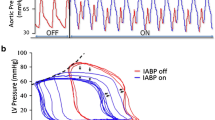Abstract
Background: Sustained hypotension, cardiogenic shock, and heart failure all imply a poor prognosis in acute myocardial infarction (MI). We assessed the benefit of adding 48 hours of intra-aortic balloon counterpulsation (IABP) to standard treatment for MI, in an international trial among hospitals without primary angioplasty capabilities.
Methods: We randomized 57 patients with MI complicated by sustained hypotension, possible cardiogenic shock, or possible heart failure to receive either fibrinolytic therapy and IABP or fibrinolysis alone. The primary end point was all-cause mortality at 6 months.
Results: In all, IABP was inserted in 27 of 30 assigned patients a median 30 minutes after fibrinolysis began and continued for a median 34 hours. Of the 27 patients assigned to fibrinolysis alone, 9 deteriorated such that IABP was required. The IABP group was at slightly higher risk at baseline, but the incidence of the primary end point did not differ significantly between groups (34% for combined treatment versus 43% for fibrinolysis alone; adjusted P = 0.23). Patients with Killip class III or IV showed a trend toward greater benefit from IABP (6-month mortality 39% for combined therapy versus 80% for fibrinolysis alone; P = 0.05).
Conclusions: While early IABP use was not associated with a definitive survival benefit when added to fibrinolysis for patients with MI and hemodynamic compromise in this small trial, its use suggested a possible benefit for patients with the most severe heart failure or hypotension.
Abbreviated Abstract. We assessed the benefit of adding 48 hours of intra-aortic balloon counterpulsation to fibrinolytic therapy among 57 patients with acute myocardial infarction complicated by sustained hypotension, possible cardiogenic shock, or possible heart failure. The primary end point, mortality at 6 months, did not differ between groups (34% for combined treatment versus 43% for fibrinolysis alone [n = 27]; adjusted P = 0.23), although patients with Killip class III or IV did show a trend toward greater benefit from IABP (39% for combined therapy versus 80% for fibrinolysis; P = 0.05).
Similar content being viewed by others
References
Goldberg RJ, Samad NA, Yarzebski J, Gurwitz J, Bigelow C, Gore JM. Temporal trends in cardiogenic shock complicating acute myocardial infarction. N Engl J Med 1999;340:1162–1168.
Becker RC, Gore JM, Lambrew C, et al. A composite view of cardiac rupture in the United States National registry of Myocardial Infarction. J Am Coll Cardiol 1996;27:1321–1326.
Eltchaninoff H, Simpfendorfer C, Franco I, Raymond RE, Casale PN, Whitlow PL. Early and 1-year survival rates in acute myocardial infarction complicated by cardiogenic shock. Am Heart J 1995;130:459–464.
Ohman EM, Topol EJ, Califf RM, et al. An analysis of the cause of early mortality after administration of thrombolytic therapy. Coron Artery Dis 1993;4:957–964.
Lee KL, Woodlief LH, Topol EJ, et al. Predictors of 30-day mortality in the thrombolytic era. Results from an international trial of 41,021 patients. Circulation 1995;91:1659–1668.
Hochman JS, Sleeper LA, Webb JG, et al. Early revascularization in acute myocardial infarction complicated by cardiogenic shock. N Engl J Med 1999;341:625–634.
Webb JG. Interventional management of cardiogenic shock. Can J Cardiol 1998;14:233–244.
Prewitt RM, Gu S, Schick U, Ducas J. Intraaortic balloon counterpulsation enhances coronary thrombolysis induced by intravenous administration of a thrombolytic agent. J Am Coll Cardiol 1994;23:794–798.
Prewitt RM, Gu S, Schick U, Ducas J. Effect of a mechanical vs a pharmacologic increase in aortic pressure on coronary blood flow and thrombolysis induced by IV administration of a thrombolytic agent. Chest 1997;111:449–453.
Gurbel PA, Anderson RD, MacCord CS, et al. Arterial diastolic pressure augmentation by intra-aortic balloon counterpulsation enhances the onset of coronary artery reperfusion by thrombolytic therapy. Circulation 1994;89:361–365.
Nanas JN, Nanas SN, Kontoyannis DA, et al. Myocardial salvage by the use of reperfusion and intraaortic balloon pump: Experimental study. Ann Thorac Surg 1996;61:629–634.
Stomel RJ, Rasak M, Bates E. Treatment strategies for acute myocardial infarction complicated by cardiogenic shock in a community hospital. Chest 1994;105:997–1002.
Kern MJ, Aguirre FV, Tatineni S, et al. Enhanced coronary blood flow velocity during intraaortic balloon counterpulsation in critically ill patients. J Am Coll Cardiol 1993;21:359–368.
Ryan TJ, Antman EM, Brooks NH, et al. ACC/AHA guidelines for the management of patients with acute myocardial infarction: 1999 update. Available at http://www.acc.org/clinical/guidelines/nov96/1999/index.htm.Accessed on 29 November 2002.
Killip T III, Kimball JT. Treatment of myocardial infarction in a coronary care unit. A two year experience with 250 patients. Am J Cardiol 1967;20:457–464.
Kovack PJ, Rasak MA, Bates ER, Ohman EM, Stomel RJ. Thrombolysis plus aortic counterpulsation: Improved survival in patients who present to community hospitals with cardiogenic shock. J Am Coll Cardiol 1997;29:1454–1458.
Anderson RD, Ohman EM, Holmes DR Jr, et al. Use of intraaortic balloon counterpulsation in patients presenting with cardiogenic shock: Observations from the GUSTO-I study. J Am Coll Cardiol 1997;30:708–715.
Barron HV, Every NR, Parsons LS, et al. The use of intra-aortic balloon counterpulsation in patients with cardiogenic shock complicating acute myocardial infarction: Data from the National Registry of Myocardial Infarction 2. Am Heart J 2001;141:933–939.
Bengtson JR, Kaplan AJ, Pieper KS, et al. Prognosis in cardiogenic shock after acute myocardial infarction in the interventional era. J Am Coll Cardiol 1992;20:1482–1489.
Ohman EM, Hochman JS. Aortic counterpulsation in acute myocardial infarction: Physiologically important but does the patient benefit? Am Heart J 2001;141:889–892.
Author information
Authors and Affiliations
Corresponding author
Rights and permissions
About this article
Cite this article
Magnus Ohman, E., Nanas, J., Stomel, R.J. et al. Thrombolysis and Counterpulsation to Improve Survival in Myocardial Infarction Complicated by Hypotension and Suspected Cardiogenic Shock or Heart Failure: Results of the TACTICS Trial. J Thromb Thrombolysis 19, 33–39 (2005). https://doi.org/10.1007/s11239-005-0938-0
Issue Date:
DOI: https://doi.org/10.1007/s11239-005-0938-0




